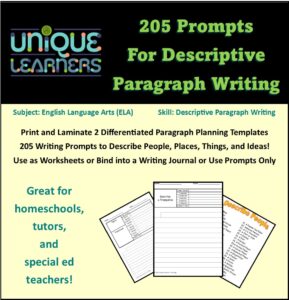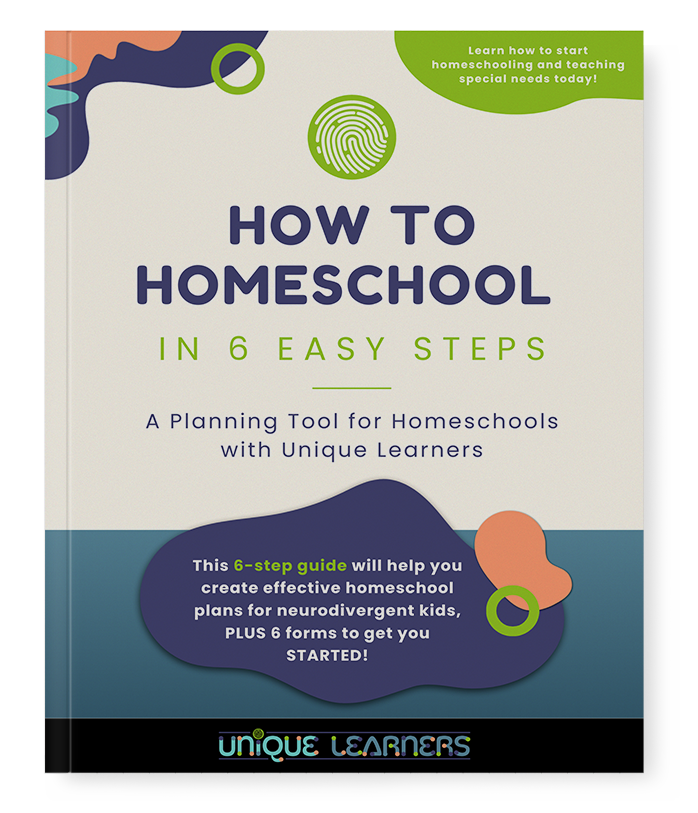For older students with language-based learning issues, writing can be a nearly impossible task. I frequently hear from homeschool parents that teaching and evaluating writing is one of the biggest challenges in homeschooling. When it comes to teaching a kid with a learning disability to do writing, parents often don’t even know where to start. I have found that many grammar curricula tend to be too abstract for our kids with language processing issues. Grammar curriculum often leaves a gap between identifying the functions of words in sentences and developing paragraph writing skills. Writing programs can make it seem like every assignment is a brand new process.

I have found a process that helps my students (even those with severe dyslexia) to become confident writers. My process includes
- Modeling the writing process
- A consistent formatted graphic organizer for the structure of a paragraph
- A simple prewriting planning process
- A proofreading strategy that reduces the emotional attachment to written expression
- An evaluation technique based on the proofreading strategy
Writing is the most difficult academic skill.
Writing is the most difficult academic skill. Writing is typically taught after a child learns to speak, read, spell, and handwrite. Written expression is an encoding skill. A writer must think of a topic, narrow it to a key idea, research as needed, organize the information. The final step is to get the information into print. The actual process of writing involves many steps. Think in complete sentences. Correctly spell all the words. Capitalizing words properly. Use punctuation accurately. And to top it off, a writer must know when a work is worthy of revision and have the humility to proofread, edit, and revise their work. These are tough demands!
Writing is a complex process.
Often, we expect a student to automatically write as well as they speak or read. Many writing programs try to give fun and creative reasons for writing. However, a kid with dyslexia, autism, or other language-based disability can become more frustrated than finding fun in the process.
I have found that a simpler process may not seem as fun to the teacher, but can help the student to feel more secure. Formatted descriptive writing prompts give students the scaffolded support to practice writing description before moving on to story writing. My advice is to allow a child to over-learn this writing skill prior to raising the expectation. Just as we learn phonics and decoding skills prior to reading fluently. Systematic progression makes the most sense to my students.

Students with language-based learning issues tend to get stuck in one or more areas of writing.
Students with language-based learning issues become easily overwhelmed with the complexities of written expression. A kid with expressive language difficulties can find writing nearly impossible. To help students find a voice and share their knowledge, I have created my own system for instructing paragraph writing that actually helps my students be willing to try.
I help my students brainstorm words based on the five senses. That way they have their own words to work from. My older students can write more vivid descriptions when I can provide more advanced synonyms for their own words Kids love to use the new, more precise words in their writing!
When we use formatted templates, the prewriting planning is on the same page that the student writes the paragraph on. I have found that using the same template each time helps my students to know that the requirements for paragraphs are the same every time. Kids learn that the words used in writing are the most important in creating word pictures for their readers.
Modeling and prewriting planning can help students know that communicating ideas is the most important part of writing.
I have created a set of 205 descriptive writing prompts are divided into prompts for People, Places, Things, and Ideas. You can get this set of description paragraph writing prompts here.

As you select topics for your students to write about, you can reinforce grammar concepts that adjectives describe nouns. The prewriting planning grid is organized to help the student brainstorm sensory words. I start with sensory adjectives by asking questions:
“What does it look like?”
“What sound does it make?”
“How does it feel?”
“Does it have a smell?”
“Can you taste it?”
I also walk through the attributes of adjectives: color, shape, size, number, appearance, and personality. I encourage my students who have mastered writing a simple, stilted paragraph to continue developing their amazing writing vocabulary so that readers can make beautiful pictures in their minds from their paragraph.
A formatted graphic organizer keeps the process simple enough to build confidence.
My system involves explicit instruction of a simple formula for paragraph development. A formatted graphic organizer gives students confidence to recall all the steps of the writing process. The confidence helps a kid take a risk to put ideas into print.
I repeatedly teach the formula, types of topic sentences, translating ideas into sentences. That way, the process becomes very familiar and safe.
Modeling is one of the most powerful teaching methods. I have found great success in shared writing of paragraphs. I model the process where together we walk through writing a paragraph together. We talk through our ideas. I write. The students copy. This modeling process helps my students to have confidence to try writing on their own.
Soon my students are willing to try the process on their own. Assuring a young writer that they can try without judgment is important.
I encourage homeschool parents to remember the joy they had when their toddler was speaking words and then sentences with the adorable language mistakes that toddlers make. Practicing writing also requires loving guidance, encouragement, and celebration when a kid successfully communicates in writing!
Learning to proofread can minimize the mundane aspects of mechanics and spelling.
Kids who struggle in writing can easily get the message that mechanics and spelling are the most important parts of writing. They aren’t. Of course, spelling, capitalization, and punctuation matter. Ideas are the most important part of writing. We can help our struggling writers to keep the main thing the main thing by doing prewriting planning first and saving proofreading as a final check process at the end.
I teach the COPS proofing strategy. The writer uses a simple checklist to look for Capitals, Organization in their paragraph, Punctuation, and Spelling. Together, each student and I look over their paragraph as I lead them through the COPS checklist. For younger kids or those who are learning mechanics, I assist in checking depending on their need. For my kids with dyslexia who are attempting to use more advanced vocabulary, I will assist in checking spelling.
If you have a kid who has great difficulty with spelling, I encourage you to proceed with caution so that spelling doesn’t move to a higher priority over content. If you have to correct more than 5 words, it may be wise to adjust the prewriting process where models can be used as a reference.
To evaluate a basic paragraph, I tally the words spelled correctly, the capitals and punctuation used correctly, and a point for each sentence that communicates about the topic. If you are required to keep grades, count the total possible points in the paragraph and divide the tallied score by the total points for a percentage score. If your homeschool uses a relaxed approach, just keep a portfolio of your child’s written work and watch the growth happen gradually!
Providing scaffolded accommodations is necessary to help students gradually gain confidence in writing.
Some kids need more support than others.
Sometimes I use the graphic organizer to brainstorm with my students to build more advanced vocabulary.
Sometimes I have the student dictate their paragraph. Then I have the student copy from the scribed paragraph in their own handwriting or type the paragraph using a computer keyboard.
We want students to have only the amount of scaffolded assistance as needed for that child’s specific needs. We want them to be successful at whatever stage they are in learning to write. Success leads to more success and builds confident writers.
In the set of description writing prompts, I have provided two blank templates: a basic planning form and a slightly more advanced planning form. For beginning writers, I am looking for the basic structure and using sensory words to describe. For more advanced students, we build in transition words and follow-up sentences for each detail.
Regardless of which graphic organizer I use for prewriting planning, or the way that students get the words on paper, I want my students to be willing to take a risk to use strong words and sentences in an organized descriptive paragraph.

I want to add one more thought. What if your child has been in public school and just could not get the hang of the 6 Traits of Writing? Does that mean that kid will never learn to write?
Actually, I have found that nearly ALL of my students who had been taught the Six Traits of Writing were more confused and shut down from frustration. While the 6 Traits may be effective for neurotypical learners, I have found that system to be too abstract for my students with language-based learning issues. They just can’t comprehend what is expected, and the rules seem to change with each assignment.
Some kids need a simple approach with consistent practice to develop writing skills.
My many years of experience have shown me that all students can become effective writers when they are given strategy training. A simple approach and consistent practice helps with writing skills. An emotionally safe relationship with the teacher helps wtih risk taking and confidence. What better setting in which to learn writing than in a loving homeschool environment?!
No matter what else you do, remind your student that writing does not need to be stressful. Express to your kids that their ideas are important and that you value what they have to say. When they write down their knowledge, other people can learn from them.
In other words, minimize the stress of the process while you maximize the importance of thoughts and ideas in writing.
Who knows? You may even find that you enjoy teaching your child to write!
